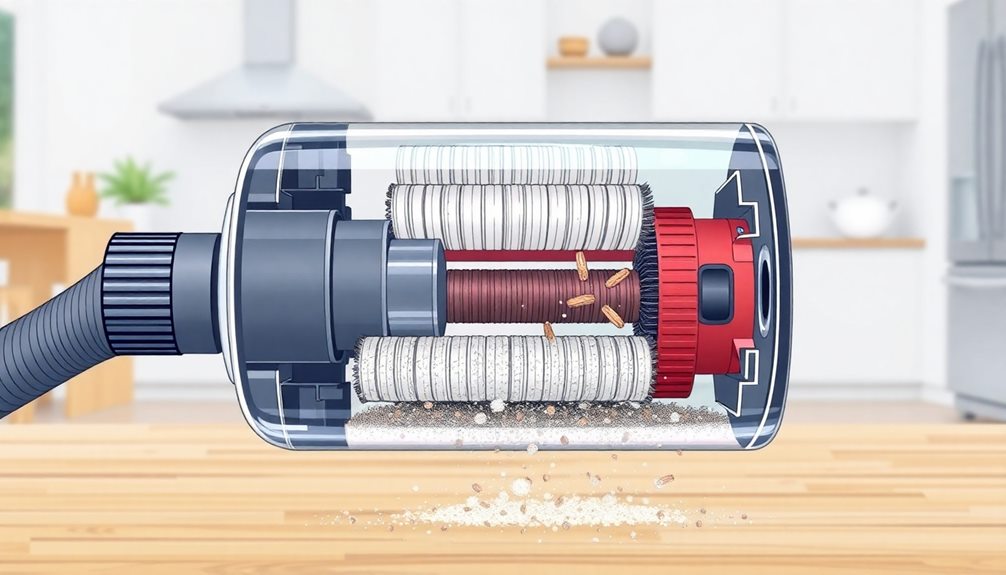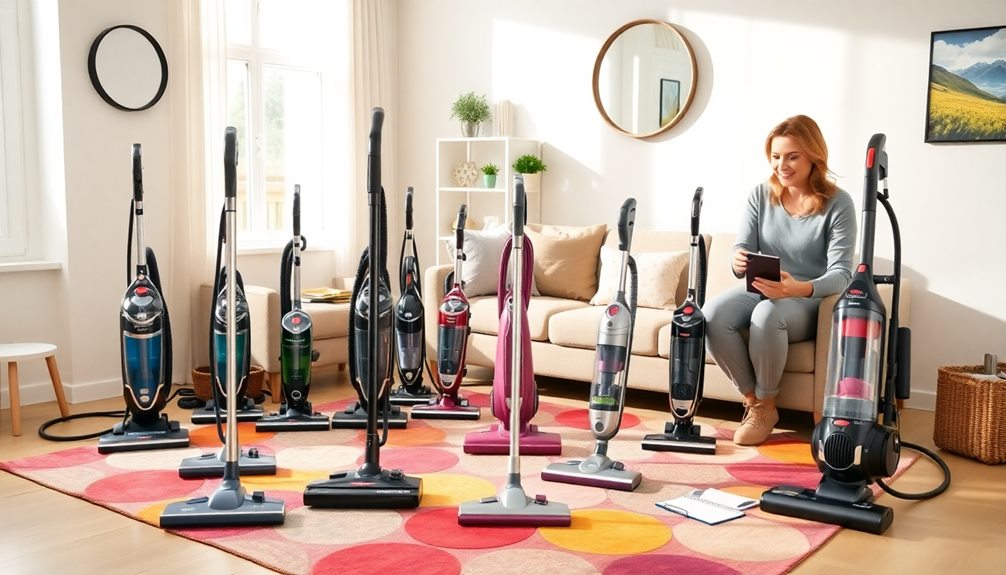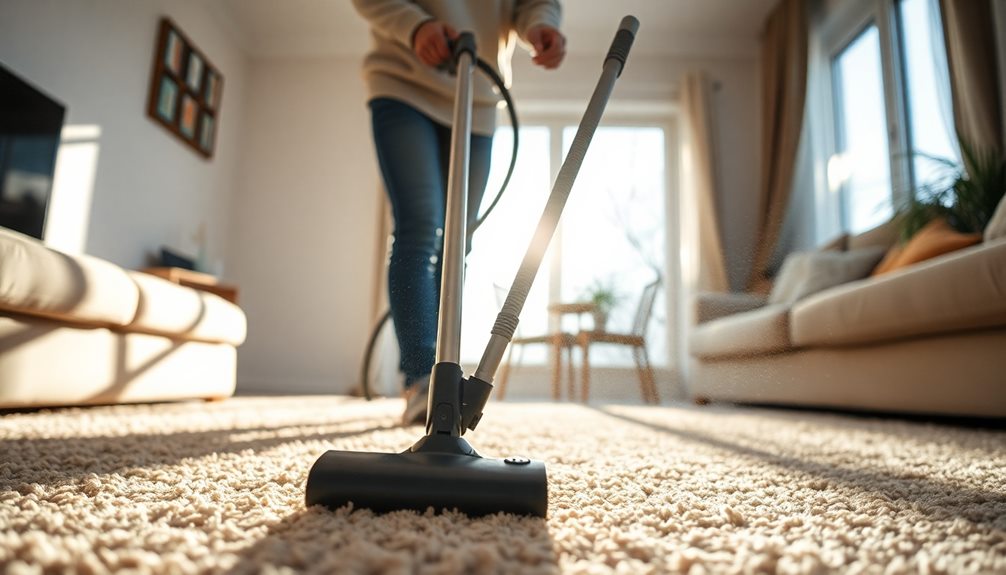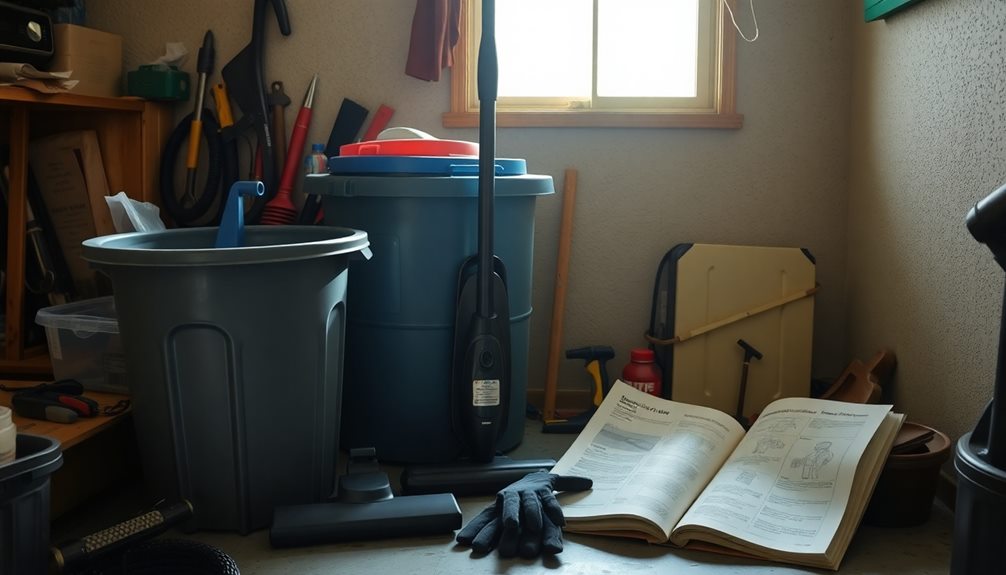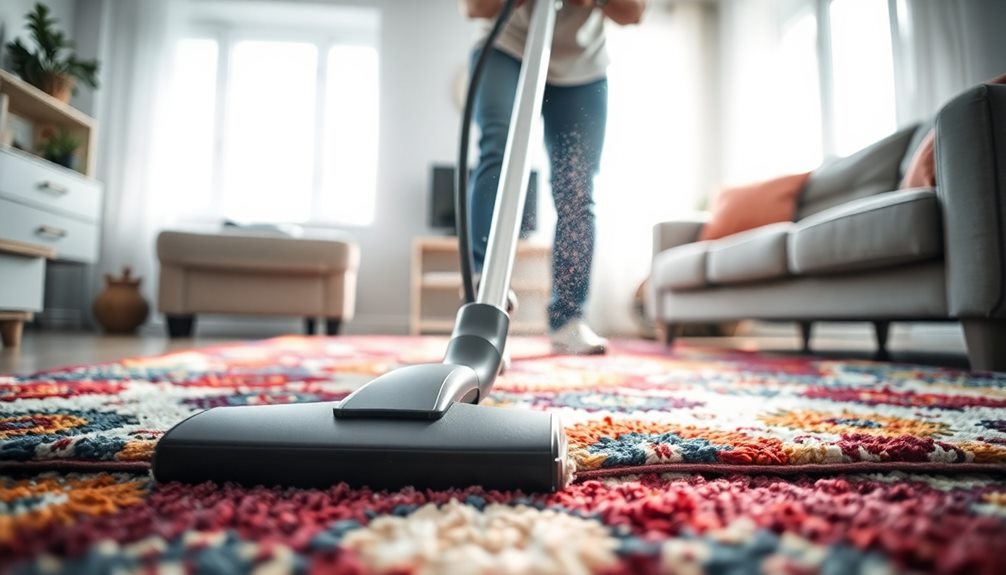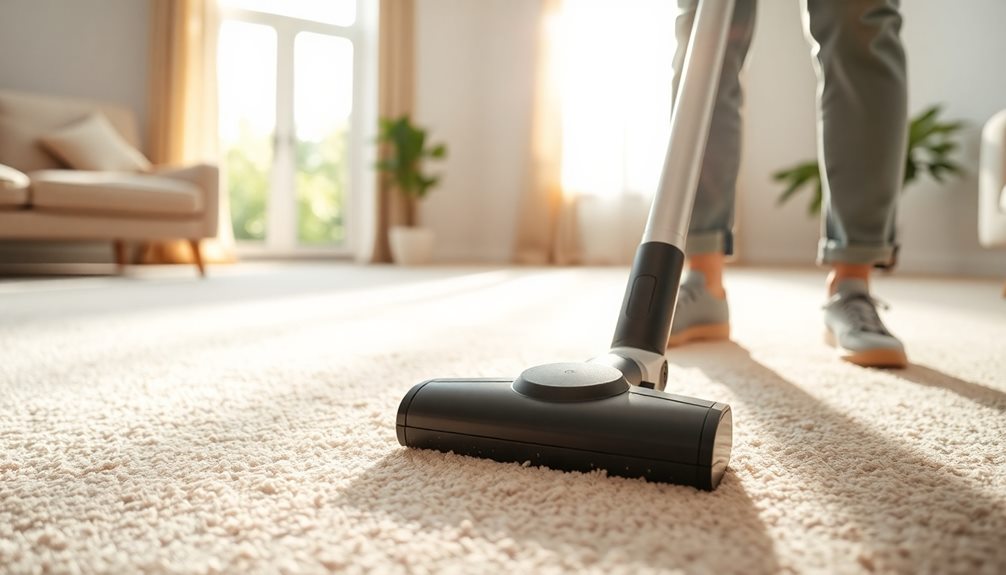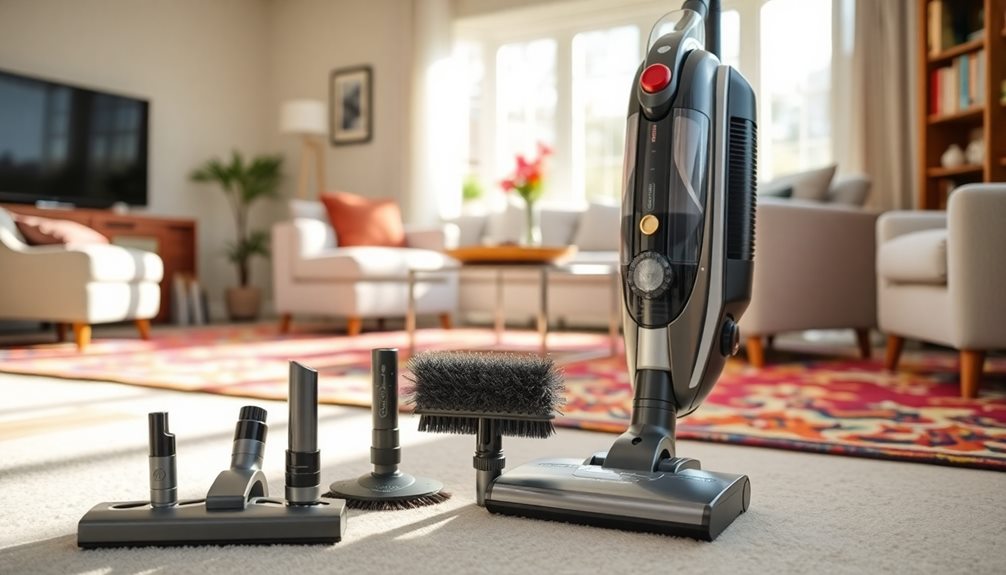To vacuum your home effectively, start by clearing the floor of small items and dusting surfaces. Choose the right vacuum based on your flooring, like an upright for carpets or a canister for versatility. Adjust the height settings for different surfaces and use attachments to reach tight spots. Vacuum slowly and systematically, beginning from the farthest corner and working towards the exit, making multiple passes over high-traffic areas. Don't forget to maintain your vacuum by emptying the bin and cleaning or replacing filters regularly. Curious about more tips to boost your vacuuming game? There's plenty more you can discover!
Key Takeaways
- Clear the floor of small items and dust surfaces before vacuuming to enhance efficiency and prevent dirt from resettling.
- Choose a vacuum suitable for your flooring type, considering suction power and HEPA filters for allergen control.
- Adjust the vacuum settings according to the surface type to ensure optimal cleaning performance and suction.
- Employ effective techniques like vacuuming in multiple directions and from the farthest corner towards the exit for thorough coverage.
- Regularly maintain your vacuum by cleaning filters and brush rolls to maintain suction power and prolong its lifespan.
Preparing Your Space
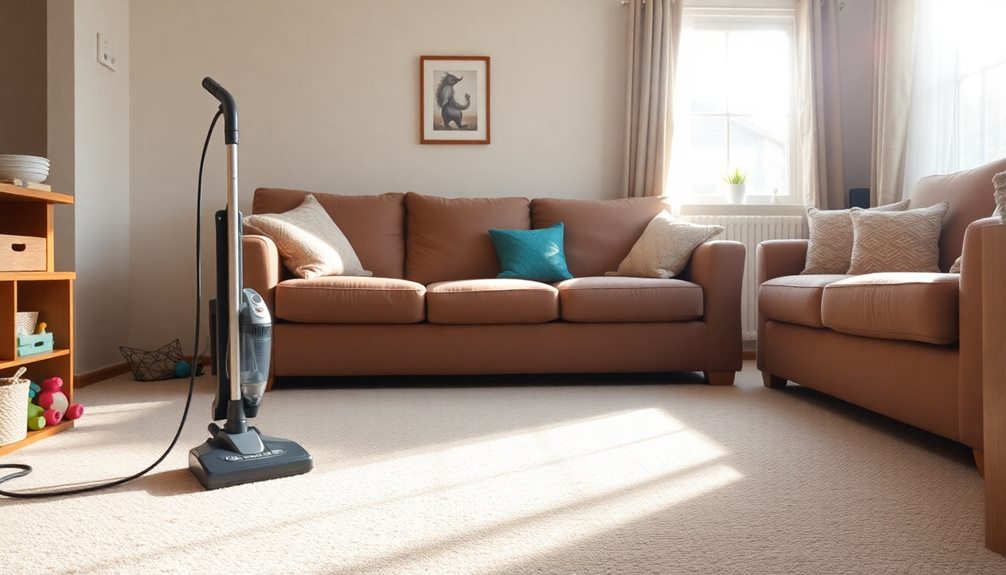
To kick off your vacuuming session, start by clearing the floor of any small items or obstacles like toys, shoes, or loose cables. This step is essential for guaranteeing a smooth and efficient cleaning process.
Next, dust and wipe down surfaces, including furniture and shelves. This helps prevent dust from settling back onto the floors after you vacuum, keeping your space cleaner for longer.
It's also important to check and empty the vacuum cleaner bag or bin before starting. A full bag can greatly reduce suction power, making your efforts less effective.
After that, consider moving lightweight furniture, such as chairs and small tables, to access hidden areas. This guarantees you cover every nook and cranny.
If you have pets, brushing them before you vacuum can minimize loose hair and dander, enhancing the overall effectiveness of your cleaning session.
Once you've prepared your space, you can put on some upbeat Músíca to make the task feel less like a chore. Enjoy the rhythm as you work, and you'll find yourself finishing the job with ease and satisfaction. Músíca can really make a difference in your vacuuming experience!
Choosing the Right Vacuum

When selecting a vacuum for your home, it's crucial to reflect on your specific cleaning needs and the types of flooring you have.
If your home has mostly carpets, an upright vacuum is generally a great choice as it provides powerful suction. However, if you have a mix of surfaces, including hard floors, consider a canister vacuum for its versatility.
If you or someone in your home suffers from allergies, look for a vacuum equipped with a high-efficiency particulate air (HEPA) filter. These filters can trap 99.97% of dust and allergens, ensuring cleaner air.
Pay attention to the vacuum's suction power, typically measured in air watts; higher suction means better dirt and debris pickup.
Also, consider the weight and maneuverability of the vacuum. If you have multiple levels in your home, a lighter vacuum will make your cleaning routine much easier.
Lastly, check the capacity of the vacuum's dustbin or bag. Larger capacities mean less frequent emptying, saving you time during cleaning sessions.
Adjusting Vacuum Settings

Adjusting your vacuum settings can greatly enhance your cleaning efficiency and effectiveness. Most vacuum cleaners come with adjustable height settings, which allow you to optimize performance on carpets, hardwood, or tile surfaces.
If you're a pet owner, look for a specific setting designed to tackle pet hair, as these often include specialized brushes or suction adjustments for better fur removal from upholstery and carpets.
When switching from hard floors to carpets, remember to adjust the suction power. Lower suction helps prevent scattering debris on hard surfaces, while higher suction is necessary for lifting deeply embedded dirt in carpets.
Some vacuum models also feature attachments like crevice tools for tight spaces or dusting brushes for delicate surfaces, enabling a more thorough cleaning tailored to different areas of your home.
Regularly checking and adjusting the vacuum settings based on your cleaning task not only enhances performance but can also prolong the lifespan of your vacuum.
Each setting is specifically designed to optimize suction and brush roll effectiveness for various surfaces, ensuring you get the best results every time you clean.
Effective Vacuuming Techniques
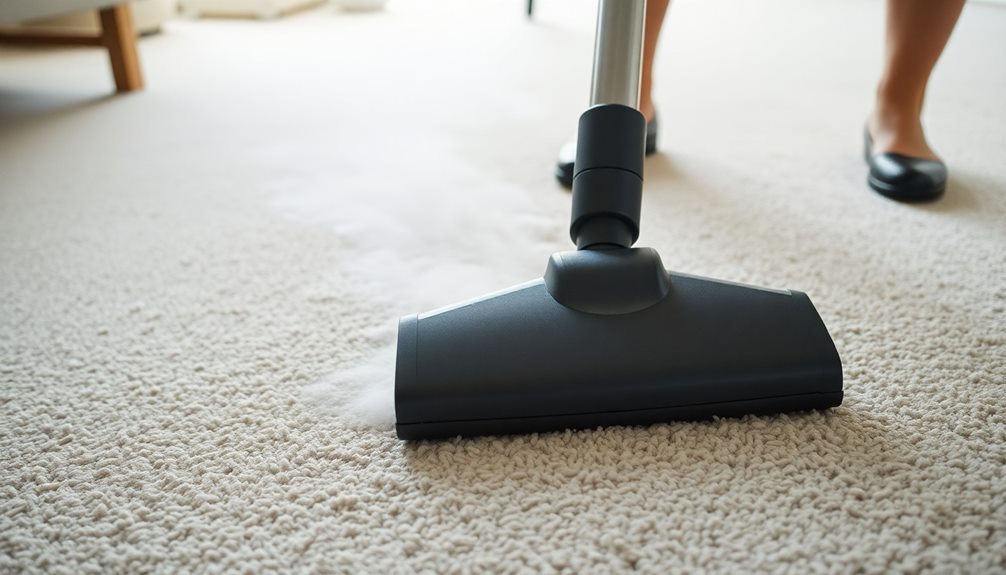
Effective vacuuming techniques can make a significant difference in maintaining a clean home. To maximize your cleaning efforts, follow these essential tips:
- Start from the Farthest Corner: Begin vacuuming in the room's farthest corner and work your way towards the exit. This way, you won't accidentally step on freshly cleaned areas.
- Use Slow, Deliberate Movements: Move the vacuum slowly and make multiple passes over high-traffic areas. This guarantees you effectively collect all dirt and debris.
- Adjust the Height Setting: Adjust your vacuum cleaner's height according to your flooring type. Use a lower setting for carpets and a higher one for hard surfaces to optimize suction.
- Maintain Your Vacuum's Performance: Regularly empty the dustbin or replace the bag. A full bin can reduce suction power by up to 50%, making it much less efficient.
Cleaning Different Surfaces

When it comes to vacuuming, knowing how to clean different surfaces is key for a thorough job.
For carpets, you'll want a vacuum with a rotating brush to lift dirt from deep within the fibers, while hard floors require a gentler touch to avoid scratches.
Understanding these techniques will help you maintain a cleaner home.
Carpet Cleaning Techniques
Cleaning carpets effectively requires the right techniques and equipment to guarantee you lift dirt and debris from the fibers. Start by using a vacuum cleaner with a rotating brush or beater bar; this feature is essential for penetrating deep into carpet fibers.
Here are some tips to improve your carpet cleaning routine:
- Adjust Settings: For high-pile carpets, set your vacuum to a higher setting to avoid bogging down. For low-pile carpets, a lower setting will work best.
- Vacuum in Multiple Directions: This technique helps lift dirt and pet hair trapped at different angles, ensuring a more thorough clean.
- Maintain Filters: Regularly clean and replace your vacuum filters to enhance suction power and efficiency, which leads to better dirt removal.
- Choose HEPA Filters: If possible, opt for a vacuum with a HEPA filter. It captures tiny allergens that standard filters often miss, improving air quality in your home.
Hard Floor Care
Maintaining hard floors requires different techniques than those used for carpets, so it's important to adjust your cleaning approach. First, always check the manufacturer's guidelines for your specific flooring type. Some vacuum cleaners may scratch or damage surfaces like hardwood or laminate, so using the right tool is vital.
Opt for a vacuum with a hard floor setting or a soft brush attachment. This way, you can effectively pick up debris without risking scratches on delicate surfaces. Regularly clean and replace your vacuum filters to guarantee peak suction power. This helps in effectively removing dirt and particles from hard floors.
When vacuuming, move in a straight line from one end of the room to the other, then back in the opposite direction. This method guarantees thorough coverage and prevents missing spots.
If you're concerned about allergens, consider using a vacuum equipped with a HEPA filter. This can trap allergens and dust particles, improving your indoor air quality while you clean.
Maintaining Your Vacuum

To keep your vacuum working efficiently, you need to regularly replace the filter and clean the brush roll.
A clogged filter can seriously impact suction power, while a dirty brush roll can hinder its performance.
Regular Filter Replacement
A crucial aspect of vacuum maintenance is regular filter replacement. Doing this every 3 to 6 months helps maintain peak suction power and prevents dust and allergens from being recirculated into your home.
Most vacuum cleaners come equipped with either washable or replaceable filters, and HEPA filters are particularly effective for trapping small particles, making them ideal for allergy sufferers.
To guarantee you're on top of filter maintenance, follow these steps:
- Check your filter type: Identify whether your vacuum has a washable or replaceable filter.
- Set a replacement schedule: Plan to replace or clean your filter every 3 to 6 months, depending on usage.
- Look for indicators: Some models have indicator lights that alert you when the filter needs replacement.
- Consult the manual: Always refer to the manufacturer's instructions for specific guidelines on filter replacement frequency and type.
Neglecting to change the filter can lead to reduced performance, higher energy consumption, and potential damage to the motor.
Stay proactive, and your vacuum will thank you!
Cleaning Brush Roll
While vacuuming regularly keeps your floors clean, neglecting the brush roll can lead to reduced performance and efficiency. To maintain your vacuum, make it a habit to check and clean the brush roll every month. This prevents hair and debris buildup that can hinder suction power.
Use scissors or a seam ripper to carefully cut away any tangled hair or fibers wrapped around the brush roll, but be cautious not to damage the bristles. If your vacuum model has a removable brush roll, refer to your owner's manual for specific instructions on how to remove and maintain it.
Inspect the brush roll for signs of wear or damage, like fraying bristles or cracks. If you notice any issues, replacing the brush roll is vital to keep your vacuum cleaning effectively.
Additionally, periodically lubricate the brush roll bearings with a drop of oil to reduce friction and extend the life of the brush roll.
Common Vacuuming Mistakes

Every time you vacuum, it's easy to overlook some common mistakes that can hinder your cleaning efforts. Avoiding these pitfalls will help you achieve a cleaner home with less effort.
Here are four common vacuuming mistakes to watch out for:
- Not Emptying the Bag or Bin: A full vacuum bag or bin can block airflow, reducing suction power. Make it a habit to empty it regularly for peak performance.
- Using the Wrong Attachments: Different surfaces require specific attachments. For example, using a beater brush on delicate rugs can cause damage. Always choose the right tool for the job.
- Skipping Maintenance: Neglecting routine checks and filter replacements can lead to poor performance and a shorter lifespan for your vacuum. Stay on top of maintenance to keep your vacuum running smoothly.
- Vacuuming Too Quickly: Rushing through vacuuming can leave dirt and debris behind. Take your time and go over each area multiple times to guarantee a thorough clean.
Tips for Efficient Vacuuming

Maximizing your vacuuming efficiency can save you time and effort, guaranteeing a cleaner home with less hassle.
Start by clearing the area of any large objects or debris. This not only allows for a thorough clean but also prevents clogs in your vacuum cleaner.
Next, use the appropriate attachments for different surfaces. For tight spaces, the crevice tool works wonders, while a brush attachment is perfect for upholstery.
When you vacuum, adopt a systematic pattern, like moving left to right or using overlapping rows. This guarantees every area gets covered without missing spots.
Regular maintenance is vital, too. Check and clean your vacuum's filters and brushes often, as clogged filters can reduce suction power by up to 50%.
Lastly, schedule your vacuuming sessions based on foot traffic and dust levels. Aim for once a week in low-traffic areas and more frequently in high-traffic zones.
Frequently Asked Questions
How Can I Use a Vacuum Cleaner at Home?
To use a vacuum cleaner effectively, start by choosing the right model for your flooring. Clear obstacles, adjust height settings, and utilize attachments for corners. Regularly empty the dust container to maintain ideal performance.
How to Properly Use a Vacuum Cleaner?
Picture a knight battling dust dragons in your castle. You've got to check the armor—empty the bag, adjust the height, and wield your tool with careful strokes. Keep it clean, and your castle will shine!
How Can I Vacuum My Room Without a Vacuum?
You can clean your room without a vacuum by sweeping with a broom, using a lint roller for upholstery, wiping surfaces with a damp cloth, or trying a carpet sweeper for rugs and carpets.
How to Create a Vacuum at Home?
To create a vacuum at home, seal your space tightly, use a powerful pump, or utilize vacuum-sealed bags. Focus on ensuring airtight containers, so you maintain the low-pressure environment effectively and efficiently.
Conclusion
In the end, vacuuming your home is like tuning a musical instrument; it takes practice and the right approach to hit all the right notes. Just as a well-tuned guitar produces beautiful music, a thorough vacuuming session creates a clean and inviting space. So, next time you grab your vacuum, remember to adjust those settings and take your time. You'll find that a little effort goes a long way in creating harmony in your home!

